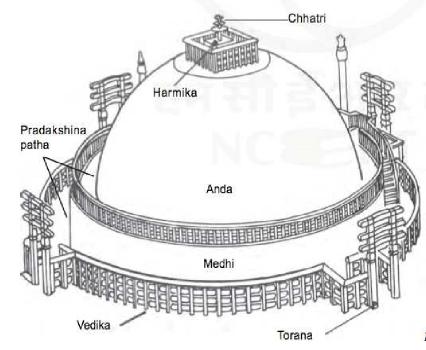4.2 Stupas
The stupa was not unknown in India before the time of Ashoka. From the time Ashoka divided up the existing body relics of the Buddha and erected monuments to enshrine them, the stupas became the objects of cult worship. In Buddhist tradition, originally the 9 stupas were built after the death of Buddha - 8 of them over the relics and 9th over the vessel in which the relics were originally deposited.Stupas were constructed over the relics of the Buddha at Rajagraha, Vaishali, Kapilvastu, Allakapa, Ramagrama, Vethadipa, Pava, Kushinagar and Pippalvina.
The core of the stupa was made up of unburnt brick and the outer face of burnt brick, covered with thick layer of plaster. The stupa was crowned by an umbrella of wooden fence enclosing a path for pradaskshina (circumambulatory path). One of the best examples of the structure of a stupa in the third century BCE is at Bairat in Rajasthan. It is a very grand stupa having a circular mound with a circumambulatory path. The great stupaat Sanchi was built with bricks during the time of Ashoka and later it was covered with stone and many new additions were made.
In the subsequent century, stupas were elaborately built with certain additions like the enclosing of the circumambulatory path with railings and sculptural decoration. There were numerous stupas constructed earlier but expansions or new additions were made in the second century BCE. The stupa consists of a cylindrical drum and a circular anda with a harmika and chhatra on the top which remain consistent throughout with minor variations and changes in shape and size. The three chhatra on the stupas represent triratnasof Buddhism i.e. Buddha (The enlightened), Dhamma (doctrine) and Sangh (order). Apart from the circumambulatory path, gateways were added. Thus, with the elaborations in stupa architecture, there was ample space for the architects and sculptors to plan elaborations and to carve out images.

Plan of Stupa
During the early phase of Buddhism, Buddha is depicted symbolically through footprints, stupas, lotus throne, chakra, etc. This indicates either simple worship, or paying respect, or at times depicts historisisation of life events. Gradually narrative became a part of the Buddhist tradition. Thus events from the life of the Buddha, the Jataka stories, were depicted on the railings and torans of the stupas. Mainly synoptic narrative, continuous narrative and episodic narrative are used in the pictorial tradition. While events from the life of the Buddha became an important theme in all the Buddhist monuments, the Jataka stories also became equally important for sculptural decorations. The main events associated with the Buddha’s life which were frequently depicted were events related to the birth, renunciation, enlightenment, dhammachakrapravartana, and mahaparinibbana (death). Among the Jataka stories that are frequently depicted are Chhadanta Jataka, Vidurpundita Jataka, Ruru Jataka, Sibi Jataka, Vessantara Jataka and Shama Jataka.
